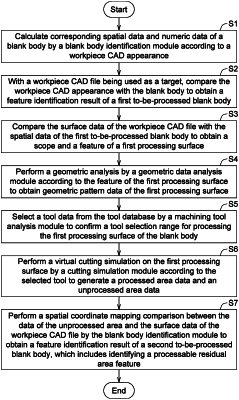| CPC G05B 17/02 (2013.01) [G06F 30/10 (2020.01); G06F 30/20 (2020.01); G06F 2111/10 (2020.01)] | 16 Claims |

|
1. A processing method for automatically generating machining features, wherein the processing method is performed by a processing system and comprises:
obtaining a workpiece CAD file to perform a CAD numerical analysis on a blank body;
with the workpiece CAD file being used as a target, comparing a workpiece CAD appearance with the blank body to obtain a feature identification result of a first to-be-processed blank body, wherein the feature identification result of the first to-be-processed blank body comprises identifying data of a to-be-removed blank body and a feature of a first processing surface;
performing a geometric analysis on the feature of the first processing surface and determining a tool selection range;
performing a virtual cutting simulation on the first processing surface according to the tool selection range to generate a processed area data and an unprocessed area data;
performing a spatial coordinate mapping comparison between the unprocessed area data and a surface data of the workpiece CAD file to obtain a feature identification result of a second to-be-processed blank body; and
performing a comparison between the feature of the first processing surface and a special geometric database to obtain a feature identification result of a third to-be-processed blank body, wherein the feature identification result of the third to-be-processed blank body comprises identifying a tool-replaceable processing area feature or a processing area feature of a special tool.
|